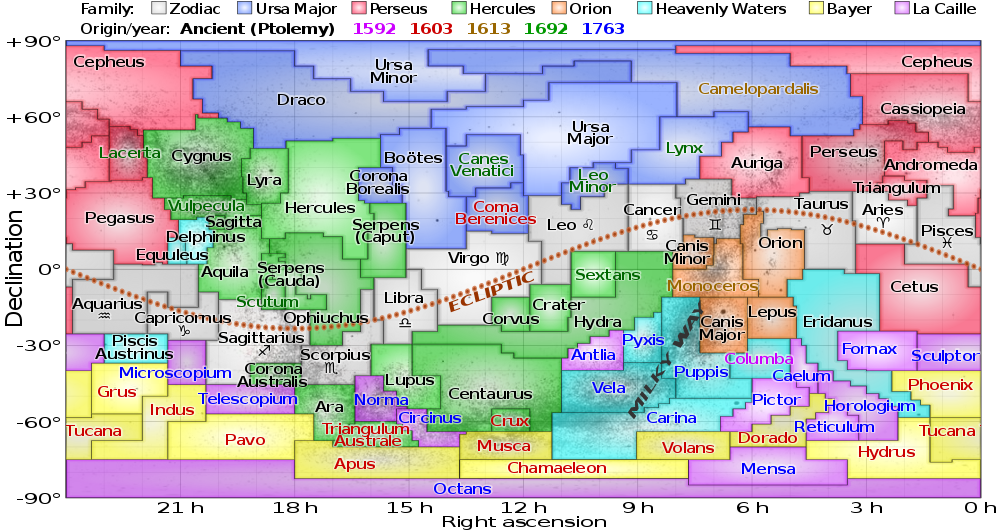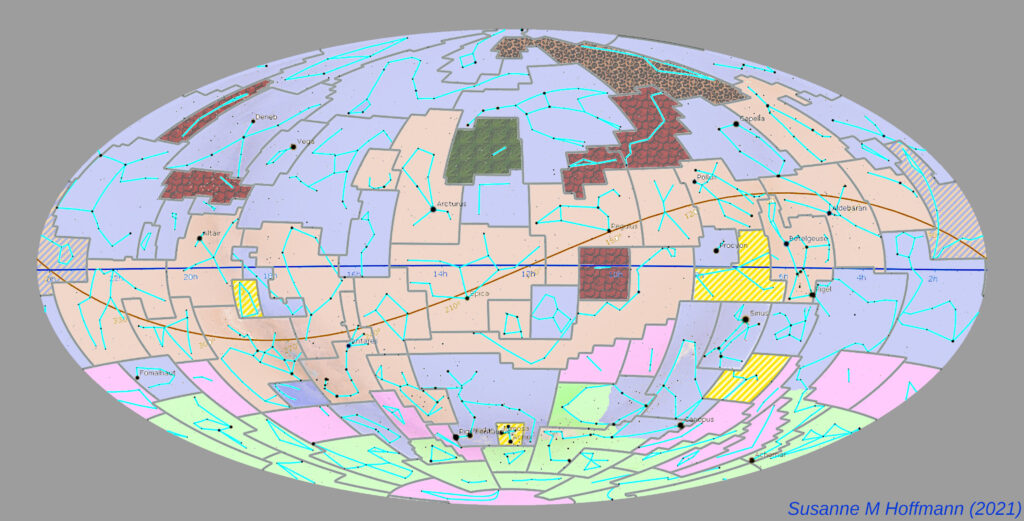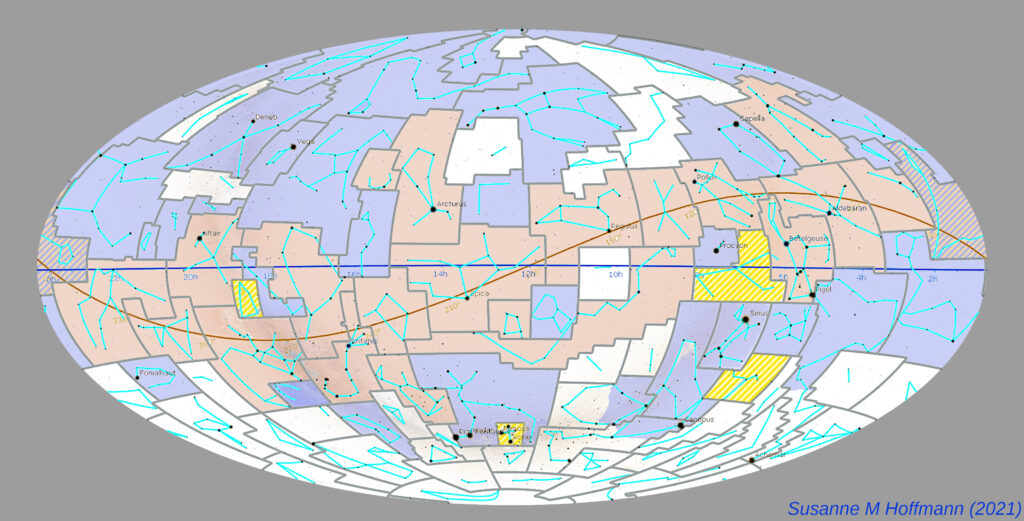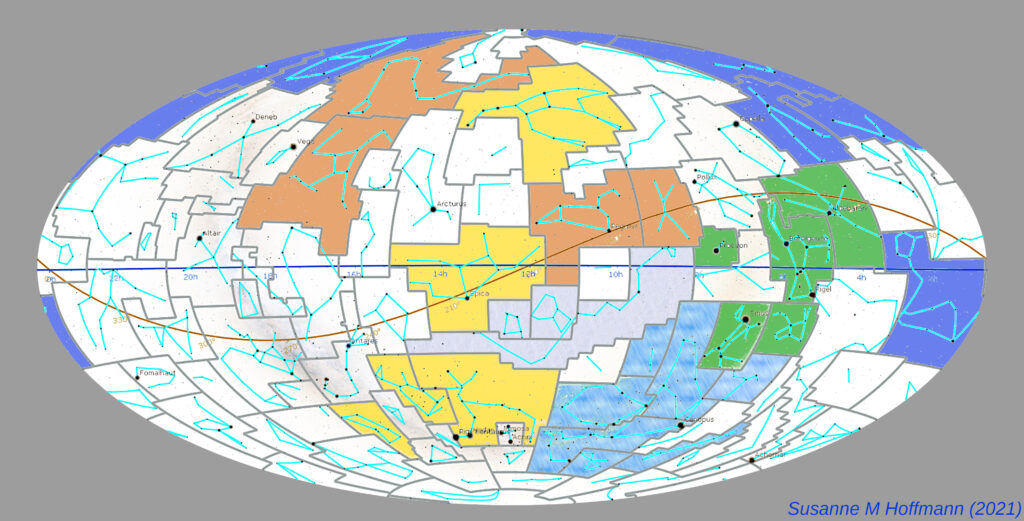In a book 1975 a director of the Harvard Observatory in the USA suggested to sort the constellations in groups. He called them “Constellation Families” and their map is today shared in the wikipedia (engl.). Here we suggest a revision.

What is depicted in the map?
Gray Family (Zodiac): The zodiac is a unit of sense because it is a band of constellations twelve of which have the same names as the signs of astrology. The thirteens constellations that is crossed by the Sun is not counted in this family in this map. Menzel’s zodiac-family is, therefore, not an astronomical definition but a mapping of the astrological concept.
Yellow Family (Bayer) and magenta Family (La Caille):
The names of the two astronomers indicate that these are groups of constellations that were depicted in a particular map of the early modern period. However, there is a fundamental difference: Lacaille deliberately reinvented constellations to fill in gaps. Bayer did not do that – he only copied what others before him had already depicted. So why is the group called “Bayer”? The origins (Author/Year) of the constellations are shown in this map by the font colour: Why should they then be coded again in the areas?
“Orion” Family, “Perseus” Family and “Ursa Major” Family.
Orion is known as the celestial hunter and his two hunting dogs and the hunting victim, the hare, belong to him – but what does the unicorn have to do with it? There is a star saga about Perseus and Andromeda in which Cetus, Cassiopeia and Cepheus also appear – nice, but what do Auriga, Pegasus and Triangulum have to do with it? … or even Lacerta (lizard)??? The Orion group and the Perseus group are sorted by mythological context – but there is no mythology linking Ursa Major with Draco (mythologically Draco belongs to Hercules) or with Corona Borealis or with the modern constellations of Lynx and Camelopardalis….
It seems as if he has only grouped together neighbouring constellations here. This could be useful, for example, when explaining the sky season by season. On the other hand, the constellations of the group “Celestial Water” are obviously not adjacent to each other, which is why this attempt to explain Menzel’s groups in a meaningful way probably does not lead to the goal.
Family of “Heavenly Waters”:
If he is trying to group everything watery together here (Ship, Eridanus, Dolphin, Southern Fish), why are Dorado, Volans and Pisces not in the group? – Presumably they were already sorted into one of the other groups mentioned above, but this suggests that this division is not particularly meaningful and that the families should be chosen differently.
Result: The map appears rather unsorted.
The idea of such a map is good in principle, but the author undertakes so many different approaches to it that contradict each other that the result seems disorganised. One should rather code either clearly according to origin or clearly according to mythological context of meaning and not both at the same time. In the case of indicating the origin, one should find the real origin and not a random work that served to disseminate the suggestions of others (e.g. neither Ptolemy nor Bayer are “origin”, but both are compilers who summarised the findings of others). Sorting with regard to a particular schema should be done according to proper definitions of the schema (and not according to a whim of the author), e.g. the zodiacal constellations: are they defined as “constellations in the path of the Sun” or “in the path of the Moon”? Menzel seems to select them according to their name similar to a zodical sign. In the case of the ship also all that belong to it (i.e. especially Volans and Dorado) … etc.
New Suggestion to improve the Map
First, let’s draw a map with the origins of constellations: The current common sense is:

light brownish: Babylonian constellations
blue: Greek constellation
light green: constellations created by Dutch sailors
(depiction on globe by Plancius 1598, in Bayer’s Uranometria 1603, and in the star catalogue published by de Houtman in 1603)
dark green:
english asterism, created in the 1670s – included in a newly invented constellation by Hevelius (1687)
dark red: Hevelius (Polish), 1687
pink: Lacaille (French), 1756
with the pattern of a leopard: Giraffe, probably invented by Plancius, too – first appearance on his 1612 globe but roots unknown
yellow: Christian.
Scutum, the shield was invented by Hevelius, Monoceros, the unicorn and Columba, the dove were (probably) invented by Plancius (for the unicorn this is uncertain); the Cross had already served as a navigational asterism for long time (introduced by A. Corsali, the navigator of A. Vespucci after a Christian asterism mentioned in their compatriot Dante’s poem) while the stars originally belonged to the constellation of the centaur.
A map of the ancient constellations only:
The same celestial map as above but with the modern constellations left as white spots.

Blue are the so-called Greek constellations (a multi-cultural mix already), brownish the Babylonian ones and yellow the (later) Christian ones.
Remark: Pisces, the two fish are coloured blue-and-brownish (striped) because the constellation has Babylonian roots but underwent several transformations. The original Babylonian constellation at this area was named “The Tails of the Giant Swallow” and later trandformed into the Uruk constellation of the “Swallow-Fish” and the Greco-Egyptian “two Fish” because for the Egyptians the Autumn Square (that was called “One Field” by the Babylonians) was a squared water tank for for the Egyptians. Thus, the modern constellation of Pisces is a product of transformations.
Mythological Groups
Colouring the map of modern constellations according to the cultural background they are connected to, we obtain a different picture:

This is a modern interpretation because the starlore is borrowed from several cultures.
dark blue: the figures of the legend of Andromeda and Perseus
(Andromeda and Perseus themselves, the sea monster called Ketos and Andromeda’s parents)
orange: myth of Hercules,
(according to Greek mythology, the hero had defeated the monster lion of Nemea, the Draco-Snake (the snake who guarded the apples of the Hesperids), and crunched a crab while fighting with a dragon.
green: the heavenly hunting scene (Orion-group)
the hunter Orion is accompanied by two hunting dogs, he fights with the bull but his (big) dog hunts a hare
light blue/ water constellations:
The giant ship (Puppis, Carina, Vela) that the Dutch had enlarged with regard to the ancient ship, is accompanied by a Flying Fish (Volans) which possibly landed on deck of the historical ship while fleeing from the huge predator Dorado.
light gray: Hydra-group
As we are defining groups with common mythological background, we could also connect Hydra with the Bowl (Crater) and the Raven (Corvus). According to Greek mythology, the raven carried the water snake to god Apollo which is not really convincing with regard to their sizes in the sky. However, it is known that both constellations were copied as a group from ancient Babylon to Greek astrometry.
golden yellow:
the “holy” Greek constellations: the altar (Ara) with its fire is the place were the gods represented by the natural force of fire witness oaths. The centaur represents the wild man who becomes civilised by sacrificing an animal at the altar. Virgo and Ursa Major symbolizse the ancient Greek rituals of initiation for men and women respectively.
Referenzen:
Zotti, G., Hoffmann, S. M., Wolf, A., Chéreau, F., & Chéreau, G. (2020). The Simulated Sky: Stellarium for Cultural Astronomy Research. Journal of Skyscape Archaeology, 6(2), 221–258. https://doi.org/10.1558/jsa.17822
Hoffmann, S. M. (2021). Wie der Löwe an den Himmel kam – Auf den Spuren der Sternbilder. Franckh Kosmos Verlag
